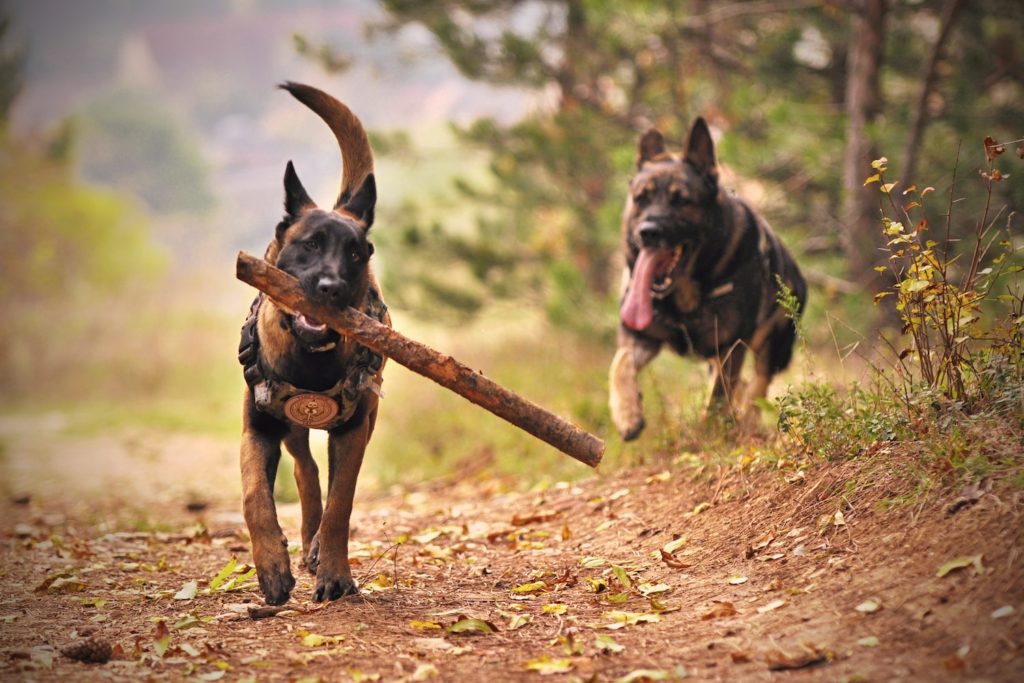Catnip is obviously for cats — it’s right in the name! But does that mean that catnip is bad for dogs? Not necessarily!
While your dog probably won’t react the same way your cat does, having them get into your kitty’s ‘nip stash doesn’t have to be scary. Let’s discuss the safety of catnip in dogs, if there are any other herbs and foods that can scratch the same itch, and ways to keep your dog happy and healthy.
What Exactly Is Catnip?
First, a little bit about what catnip is — other than that green stuff that makes your cat act “happy.” Catnip is an herb that belongs to the mint family, although it doesn’t taste super minty. The active substance in catnip is nepetalactone, which can cause a response in cats with a genetic sensitivity.
Most cats that have inherited that genetic sensitivity will react to catnip by rolling in it, rubbing their face on it, running around, and eventually zoning out. The reaction usually lasts no more than 10 minutes, but it’s super fun to watch.
On the other hand, dogs don’t have the same genetic predisposition (although they do have a reaction — which we’ll discuss in more depth later!) But the real question is, is catnip bad for dogs? Do you need to be worried about it?
Can Dogs Ingest Catnip?
Although your dog won’t have the same energetic reaction to catnip as your cat does, nothing about the herb is considered “bad” for them.
As an herb, catnip also has several nutritional benefits — it’s jam-packed full of vitamins C and E, magnesium, and flavonoids (natural substances known for their positive health effects). Dogs need many of the same nutrients that we do, just in different amounts.
Interestingly enough, that active substance — nepetalactone — may trigger the opposite effect in dogs that it triggers in cats. While cats experience a stimulant reaction, making their pupils dilate as they race around the house, catnip can cause dogs to feel sleepy and more relaxed.
If you want to see the effect, try sprinkling ¼ to ½ a teaspoon of catnip on their regular food. If you have whole catnip leaves, you could float a few in their water bowl instead. Remember, dogs react differently, so they may not act as you’d expect. Start with a small amount and monitor them closely, then go from there!
What Else Can Help Lower My Dog’s Stress Level?
With catnip’s surprising sedative effects on dogs, you may ask yourself — what else can I do to help keep my dog’s stress level low?
Dogs show stress differently than we do, although there are more similarities than you’d think. Like humans, many dogs pace when their anxiety starts to climb. They may also lose their appetite or become less active, choosing to stay in bed — sound familiar?
Lowering their stress level can help them feel better mentally and maintain a healthy immune system. It starts by identifying the source of their stress and finding ways to minimize or remove it.
For example, does your dog suffer from separation anxiety? They may benefit from crate training or some positive reinforcement training. Are there problems between your dog and another pet in the household? You may need to call a dog behaviorist to help sort them out.
CBD has also shown much promise for soothing feelings of stress or related behaviors when given at least two hours before a stress-triggering event. When combined with ways to change their environment to make it less stressful, you can help your dog lead a calmer existence. Ensuring your dog gets enough exercise is also important, as exercise can help them burn off that extra energy.
Are There Other Safe Herbs My Dog Can Eat?
Not every herb we (or our cats) use is as safe for our canine friends. Knowing what you can and can’t give to your dog is crucial for keeping them safe and secure.
However, several are not just safe but may be able to add a few benefits to your dog’s diet – just make sure to talk to your veterinarian before starting any (especially if your dog is already on other medications or has any chronic health conditions).
- Mint – Catnip is in the mint family, so it would make sense that mint would be just as good for your dog. Chopping up a bit of mint is especially good for dogs dealing with bad dog breath, as it can act like a canine breath freshener.
- Sage – Sage contains many of the same vitamins and minerals as catnip, especially vitamin E and magnesium. Some people believe that it also can help dogs with seasonal allergies.
- Turmeric – If you haven’t yet explored the wonders of turmeric for yourself, what’s stopping you? Turmeric is known for its potential to help reduce inflammation and act as an antioxidant.
Mix these herbs with whole fruits and vegetables on the ASPCA safe list — apples, blueberries, bananas, carrots, green beans, pumpkin, etc. Just make sure that you’re feeding anything outside of your dog’s food in careful moderation.
A few bites at a time is all they need; anything more than that can add unnecessary calories and lead to obesity problems (even if they’re healthy, natural foods).
In Summary
While your dog won’t likely react by getting extra energetic and rolling around in it, the answer to “is catnip bad for dogs?” is no – not at all! In many dogs, catnip can create the opposite reaction, acting as a sedative and helping to calm them down (when used in moderation, of course).
However, every dog is different, and there is always the possibility of an allergic reaction, so use it with caution.
Sources:
Crazy for catnip | The Humane Society of the United States
Sharing is Caring: Foods You Can Safely Share with Your Pet | ASPCA









